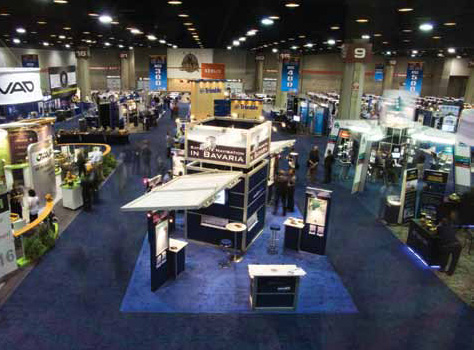 ION GNSS 2012 exhibition hall. Institute of Navigation photoo
ION GNSS 2012 exhibition hall. Institute of Navigation photooThe Institute of Navigation ION GNSS 2012 conference in Nashville, Tennessee, last week (September 18–21, 2012) lived up to its reputation as a premiere forum for new GNSS product announcements.
The Institute of Navigation ION GNSS 2012 conference in Nashville, Tennessee, last week (September 18–21, 2012) lived up to its reputation as a premiere forum for new GNSS product announcements.
GNSS OEM receiver modules, simulators, antennas, integrated GNSS/inertial and GNSS/wireless products, stand-alone inertial sensors intended for integration with GNSS, end user equipment, and even differential GPS (DGPS) beacon transmitters.
GNSS OEM, Integrated Modules
Topcon Positioning Systems launched an ultra-compact, dual-frequency positioning engine, the B110 GNSS receiver board. The B110 is the first GNSS board incorporating Topcon’s new Vanguard ASIC, supporting 226 universal channels for GPS, GLONASS, Galileo, and satellite-based augmentation system (SBAS) tracking and scalable positioning (up to 100-hertz update rate) from sub-meter DGPS to sub-centimeter RTK. The B110 board’s small size (40×55 millimeter footprint), low power consumption, and flexible communication interfaces are designed to facilitate integration into any precise positioning application, reducing the time-to-market for OEM customers. The company has created a new OEM website for developers to obtain product information about Topcon’s various OEM boards and receivers.
Trimble introduced the company’s BD920-W3G receiver and communication module. As part of Trimble’s GNSS OEM portfolio, the new compact module features real-time kinematic (RTK) positioning capabilities coupled with flexible Wi-Fi, Bluetooth, and cellular communication options for precise, mobile positioning that enables system integrators and OEMs to quickly add GNSS centimeter-level positioning to specialized or custom hardware solutions. Wireless communications and Ethernet connectivity are available on the module to allow high-speed data transfer and configuration via standard Web browsers. USB and RS232 are also supported. The Trimble BD920-W3G is expected to be available in the first quarter of 2013 through Trimble’s Precision GNSS + Inertial sales channel worldwide.
NovAtel Inc. has added its SPAN GNSS/inertial navigation system (INS) technology to the company’s OEM6 GNSS receiver platform to provide continuously available, position, velocity and attitude (roll, pitch, yaw), even during short periods of time when satellite signals are blocked or unavailable. With shipments beginning this month, NovAtel’s SPAN technology will be supported on OEM615 and OEM628 board level receivers and the FlexPak6 receiver, providing integrators a rugged enclosed platform that can be paired with the company’s complete range of IMU sensors. The OEM615 and 628 boards replace NovAtel’s legacy OEMV receivers.
NVS Technologies AG announced the NV08C-Mini PCI-E, a fully integrated GNSS receiver module, optimized for Mini PCI Express (Mini-PCIe)–based applications. According to the company, the module’s key feature is full compatibility with GPS, GLONASS, Galileo, and Compass GNSS systems as well as satellite-based augmentation systems: QZSS, EGNOS, WAAS, MSAS, and GAGAN. The NV08C-Mini-PCis specifically designed for integration into a wide range of computer-based navigation, positioning, and timing equipment.
Antennas
NovAtel unveiled its new Pinwheel OEM, an antenna module designed for easy integration into end-user GNSS positioning products. The Pinwheel OEM has a small form factor measuring only 143 x 30 millimeters. According to the company, the antenna module receives GPS L1/L2, GLONASS L1/L2 and L-band signals and provides increased multi-path rejection and phase center stability.
NavXperience, of Berlin, Germany, introduced the 3G+C, a multi-GNSS antenna, capable of receiving signals from GPS, Galileo, GLONASS, and Compass satellites. The antenna was developed in collaboration with Fraunhofer Insitute for Integrated Circuits IIS. According to the company, the new antenna meets or exceeds phase center eccentricity standards up to one millimeter and is suitable for such purposes as high-precise geodetic applications as well as integration into agricultural and construction machinery or vehicles. The unit’s hexagonal casing structure and a specially developed laser welded joint are designed to make the 3G+C water-, dust- and shockproof in even the harshest environmental conditions.
Simulators
Spectracom demonstrated its new L1+L2 dual-frequency, 32-channel multi-GNSS simulator, the GSG-62, which offers multiple frequency operation, multiple GNSS constellation simulation, and expansion capability for more RF bands and channels. The GSG-62 is designed for manufacturing and development testing with its ability to simulate all the visible satellites for the receiver under test. With 16 channels for L1 frequency and 16 channels for L2 frequency, channels can be assigned to GPS or GLONASS, P-code or C/A code. Channels may also be used for SBAS simulation of EGNOS, WAAS, GAGAN, or MSAS satellites, or for multipath and interference signals.
Silicom introduced ECHO L, a new GNSS signal recorder. ECHO L can record up to three GNSS signals simultaneously at up to 400Mbytes/second transfer rate. It records I/Q on 14 bits at 100MS/second for each of the three channels and allows the user to select carrier frequency (L band), sampling frequency, number of bit, and recording duration independently (within the limits of the transfer data rate).
DEIMOS Space announced the introduction of GRIP (GNSS Receiver Prototype Builder) for its GRANADA simulator. GRIP enables the implemention and analysis of receiver algorithms on real hardware with a real-time user interface in Matlab, allowing access to internal receiver registers. GRIP features GPS and Galileo signals, including E5 AltBOC. The company also announced the new release of the GNSS Blockset for Matlab/Simulink and the Environment and Navigation software simulation tool to design and study new signal processing algorithms and receiver architectures. In the GRANADA, the blockset enables analysis of GPS and Galileo constellation performance and the generation of raw receiver data observables.
Averna launched RF Studio, workflow software that records and manages real-world RF signals. RF Studio’s first deployment, called RF Studio Recorder, comes embedded on the Averna RP-5300 Series RF Recorder. It is designed for making RF recordings, managing collected data, and analyzing or playing back collected RF environments.
IFEN and WORK Microwave revealed enhancements to their NavX-NCS multi-GNSS (GPS, GLONASS, Galileo, SBAS) RF constellation simulator product line, including multi-RF output, optimized software, remote control, and NavMsg logging and input capabilities. The simulator provides up to nine L-band frequencies and 108 channels.
Inertial Products
Sensonor presented its new inertial measurement unit, STIM300, a small, light non-GPS–aided commercial MEMS inertial measurement unit (IMU) comprised of the highly accurate MEMS gyros, three high-stability accelerometers, and three inclinometers. Sensonor says the STIM300 is a cost-effective ITAR-free solution for systems that only had fiberoptic gyros as an alternative when reaching for a comparable performance level.
YEI Technology announced a high-precision, navigation grade IMU/AHRS, the YEI 3-Space HIPerGyro. According to the company, the unit combines the high accuracy and performance characteristics of traditional optical and mechanical IMUs with the reduced size, weight, and power consumption advantages of micro-electro-mechanical system (MEMS)-based devices. The YEI 3-Space HiPerGyro uses a combination of gyroscope, accelerometer, magnetometer, and barometer sensing elements in conjunction with advanced on-board processing and filtering algorithms to achieve ultra-accurate inertial measurements and attitude/heading outputs in real-time.
SBG Systems, a relatively new company based in Ruell Malmaison, France, showed its “SmartFusion” data fusion engine — embedded in the company’s IG-500 series MEMS-based range of inertial systems — designed to enhance vehicles stabilization and navigation. At the core of SmartFusion is a deep redesign of the on-board extended Kalman filter, based on field motion data. Using thousands of hours of data logs recorded by valued customers, SBG engineers tuned and validated complex algorithms of sensor behavior on various platforms and in different operating environments. According to the company, the SmartFusion engine supports improved vibration immunity, reduced latency, and 1000-hertz coning integrals to track high-speed motion and get a more accurate orientation.
Also of Note
Southern Avionics released a new design and product line expansion for its differential GPS (DGPS) transmitters. The design uses hot-swappable modules, each providing up to 750 watts of output power. Each module consists of a power supply regulation stage, power controller, switching power amplifier, post filter, and power monitoring stage. In addition to Southern Avionics’ 200-, 500-, and 1,000-watt transmitters, the company has added two new high-power DGPS transmitters. The SC1500 has an output power of 75–1500 watts and is fully upgradable to 2,250 and 3,000 watts with the addition of 750-watt power modules. The SC3000 has an output power of 75–3,000 watts. All of the transmitters can be remotely monitored or over an Ethernet server.
Trimble’s Infrastructure business unit announced hardware and software products that take advantage of Trimble RTX (Real-Time eXtended) technology, which provides GNSS corrections. According to the company, RTX technology employs real-time GNSS corrections from a global reference station network to compute centimeter-level positions based on satellite orbit and clock information. The Trimble NetR9 reference receiver now offers global correction data processing using the RTX technology, employing corrections via L-band satellite or IP (cellular) links for coordinate and tectonic monitoring applications. In the Infrastructure Pivot portfolio, two key applications use Trimble RTX technology to provide centimeter-level real-time position accuracy: the Pivot RTX App is designed to perform absolute position monitoring in real-time for a network of receivers, while the Pivot RTX-PP App is designed to perform absolute position monitoring in postprocessing mode, supporting either static or kinematic processing.
ITT Exelis announced the Exelis GPS Interference Detection and Geolocation (IDG) capability that can provide near real-time geolocation of intentional and unintentional GPS jamming sources through a network of sensors (Chronos Technology’s CTL3500 handheld GPS jamming detector) advanced geolocation technology. IDG technology is based upon a network of threat detection sensors that are networked to a centralized server running Exelis-developed geolocation algorithms. These sensors would be strategically located around high-risk areas, such as airports or utility grids, to instantaneously sense and triangulate the location of the jamming source. According to ITT Exelis, should a threat be detected, users would receive pinpoint geolocation information and actionable intelligence in order to respond.




